check engine Lancia Thesis 2006 Owner handbook (in English)
[x] Cancel search | Manufacturer: LANCIA, Model Year: 2006, Model line: Thesis, Model: Lancia Thesis 2006Pages: 386, PDF Size: 8.69 MB
Page 314 of 386
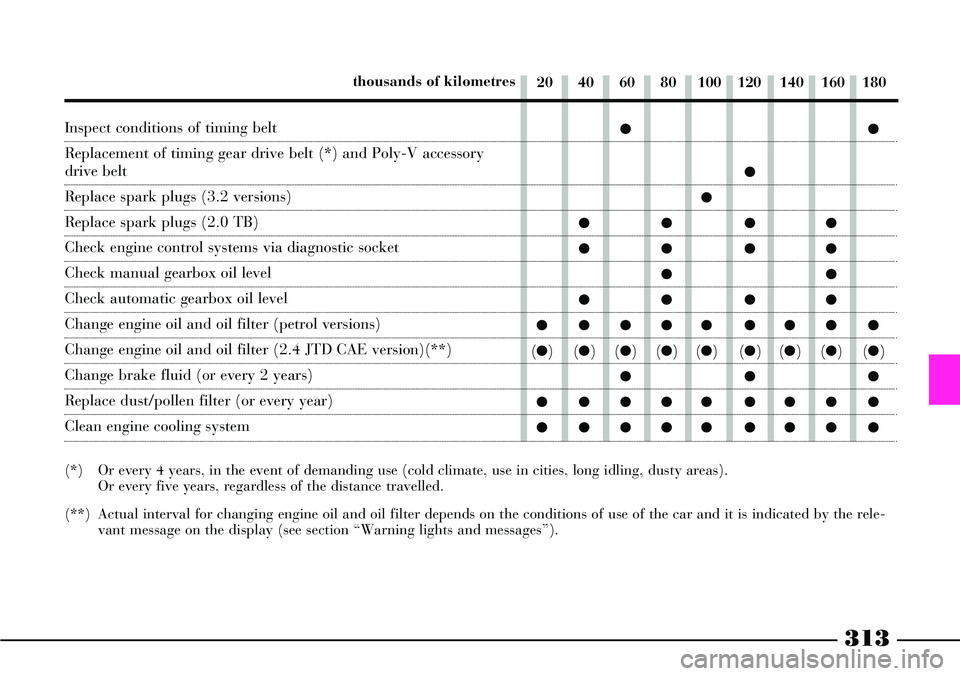
313
Inspect conditions of timing belt
Replacement of timing gear drive belt (*) and Poly-V accessory
drive belt
Replace spark plugs (3.2 versions)
Replace spark plugs (2.0 TB)
Check engine control systems via diagnostic socket
Check manual gearbox oil level
Check automatic gearbox oil level
Change engine oil and oil filter (petrol versions)
Change engine oil and oil filter (2.4 JTD CAE version)(**)
Change brake fluid (or every 2 years)
Replace dust/pollen filter (or every year)
Clean engine cooling system
(*) Or every 4 years, in the event of demanding use (cold climate, use in cities, long idling, dusty areas).
Or every five years, regardless of the distance travelled.
(**) Actual interval for changing engine oil and oil filter depends on the conditions of use of the car and it is indicated by the rele-
vant message on the display (see section “Warning lights and messages”).20 40 60 80 100 120 140 160 180 thousands of kilometres
çç
ç
ç
çç çç
çç çç
çç
çç çç
ççççç çççç
(ç)(ç)(ç)(ç)(ç)(ç)(ç)(ç)(ç)
ççç
ççççç çççç
ççççç çççç
Page 315 of 386
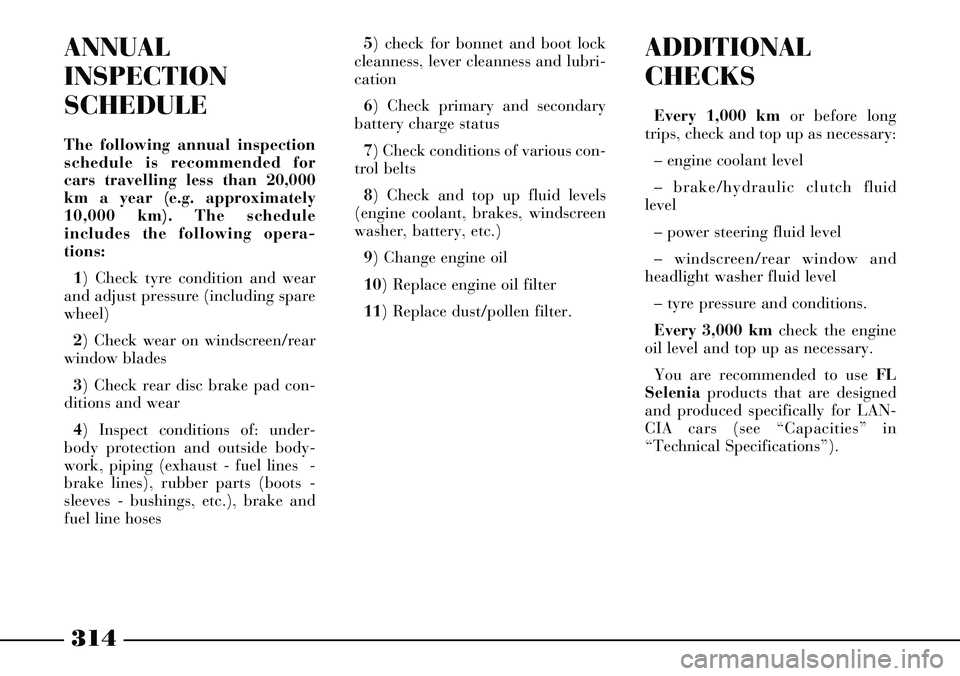
314
ADDITIONAL
CHECKS
Every 1,000 kmor before long
trips, check and top up as necessary:
– engine coolant level
– brake/hydraulic clutchfluid
level
– power steering fluid level
– windscreen/rear window and
headlight washer fluid level
– tyre pressure and conditions.
Every 3,000 kmcheck the engine
oil level and top up as necessary.
You are recommended to use FL
Seleniaproducts that are designed
and produced specifically for LAN-
CIA cars (see “Capacities” in
“Technical Specifications”).
ANNUAL
INSPECTION
SCHEDULE
The following annual inspection
schedule is recommended for
cars travelling less than 20,000
km a year (e.g. approximately
10,000 km). The schedule
includes the following opera-
tions:
1) Check tyre condition and wear
and adjust pressure (including spare
wheel)
2) Check wear on windscreen/rear
window blades
3) Check rear disc brake pad con-
ditions and wear
4) Inspect conditions of: under-
body protection and outside body-
work, piping (exhaust - fuel lines -
brake lines), rubber parts (boots -
sleeves - bushings, etc.), brake and
fuel line hoses5) check for bonnet and boot lock
cleanness, lever cleanness and lubri-
cation
6) Check primary and secondary
battery charge status
7) Check conditions of various con-
trol belts
8) Check and top up fluid levels
(engine coolant, brakes, windscreen
washer, battery, etc.)
9) Change engine oil
10) Replace engine oil filter
11) Replace dust/pollen filter.
Page 317 of 386

316
IMPORTANT - Diesel filter
The different grades of purity in
diesel fuel normally available might
make it necessary to replace the fil-
ter more frequently than indicated
in the Service Schedule. If the engine
misfires it shows the filter needs
changing.IMPORTANT - Dust/pollen filter
If the car is often used in dusty or
extremely polluted environments,
you should change the filter element
more frequently. It should be
changed especially if the amount of
air introduced into the passenger
compartment is reduced.IMPORTANT - Battery
The charge in your battery should
be checked, where possible at the
start of the winter, to limit the risk
of the battery electrolyte freezing.
This check should be carried out
more frequently if the car is mainly
used for short trips or if it is fitted
with accessories that permanently
take in electricity even when the
ignition key is removed, especially in
the case of after market accessories.
If the car is used in very hot cli-
mates or particularly demanding
conditions check the battery elec-
trolyte more frequently than shown
in the “Service Schedule” in the
“Car maintenance” chapter.
Page 318 of 386
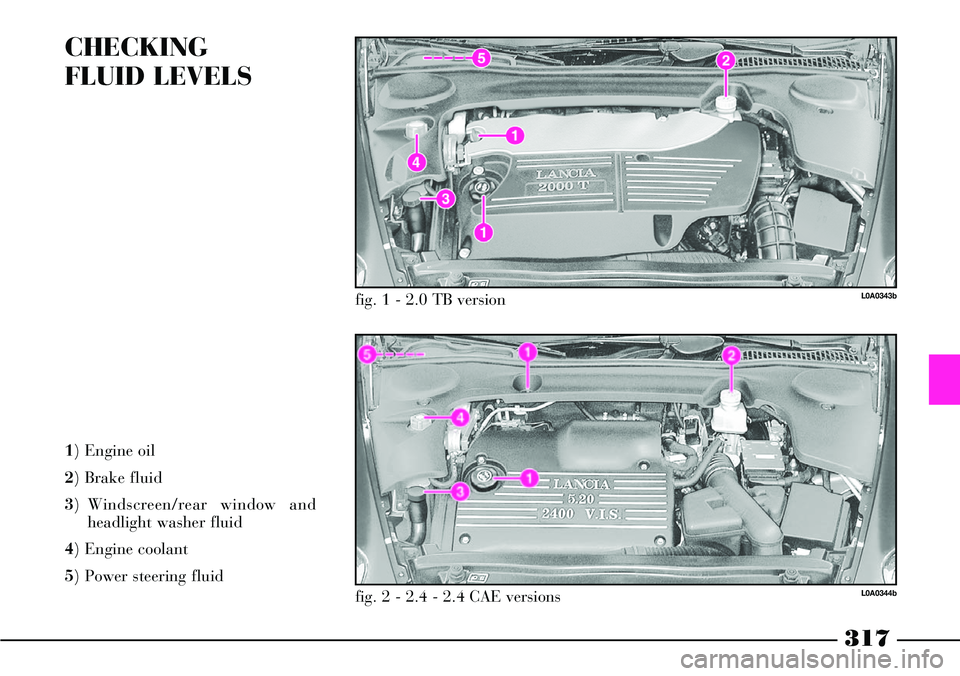
317
CHECKING
FLUID LEVELS
1) Engine oil
2) Brake fluid
3) Windscreen/rear window and
headlight washer fluid
4) Engine coolant
5) Power steering fluid
L0A0343b
L0A0344b
fig. 1 - 2.0 TB version
fig. 2 - 2.4 - 2.4 CAE versions
Page 321 of 386

320
IMPORTANTAfter topping up, let
the engine turn for a few seconds
and wait a few minutes after stop-
ping it before you check the level.
Engine oil consumption
Max. engine oil consumption is
usually 400 grams every 1000 km.
When the car is new, the engine
needs to run in, therefore the engine
oil consumption can only be consid-
ered stabilised after the first 5000 -
6000 km. ENGINE OIL
(fig. 7-8-9-10-11-12)
Check engine oil with the car on
level ground and while the engine is
still warm (approximately five min-
utes after stopping the engine).
Remove dipstick Aand clean it,
than plunge it down and check
whether the oil level is included
between the MINand MAXrefer-
ence lines on the dipstick. The gap
between the MINand MAXrefer-
ence lines corresponds to approxi-
mately one litre of oil.Do not add oil with dif-
ferent specifications (class,
viscosity, etc.) from the oil
already in the engine.
If the oil level is near or even below
the MINline, pour in oil through the
filler hole B, until it reaches the
MAXline.
IMPORTANTIf during a routine
check you will find that the oil level
is above the MAXreference line,
contact a Lancia Dealershipto
have the proper level restored. Be very careful under the
bonnet: you risk burning
yourself. Rememberthat
when the engine is hot, the fan
can start up and cause injuries.
fig. 7 - 2.0 TB version
L0A0323b
fig. 8 - 2.4 - 2.4 CAE versions
L0A0291b
Page 322 of 386

321
IMPORTANTThe oil consump-
tion depends on the driving style and
the conditions under which the car is
used.Used engine oil and re-
placed oil filters contain
substances which can harm
the environment. We recommend
you have the car seen to at a Lan-
cia Dealership for the oil and filter
change. It is suitably equipped for
disposing of used oil and filters in
an environmentally friendly way
that complies with the law.ENGINE COOLANT (fig. 13)
Do not remove the reser-
voir cap when the engine is
hot: you risk scalding
yourself!
Check coolant level when the engine
is cold and with the car on flat
ground. The level should be includ-
ed between MINand MAXreference
lines on the reservoir.
If the level is low, loosen the reser-
voir cap Aand top up with
PARAFLU UPuntil reaching the
MAXreference line.
fig. 9 - 2.4 JTD version
L0A0324b
fig. 11 - 3.0 V6 CAE version
L0A0155b
fig. 13
L0A0292b
fig. 10 - 2.4 JTD 20V -
2.4 JTD 20VCAE versionsfig. 12 - 3.2 V6 CAE version
L0A0346bL0A0359b
Page 323 of 386
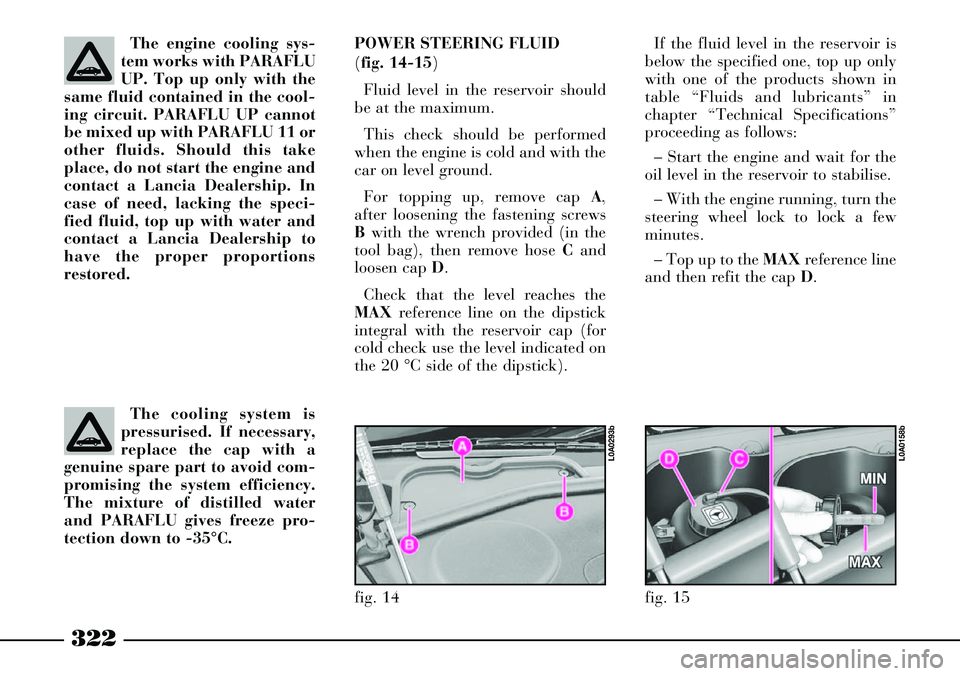
322
fig. 14
L0A0293b
fig. 15
L0A0158b
The engine cooling sys-
tem works with PARAFLU
UP. Top up only with the
same fluid contained in the cool-
ing circuit. PARAFLU UP cannot
be mixed up with PARAFLU 11 or
other fluids. Should this take
place, do not start the engine and
contact a Lancia Dealership. In
case of need, lacking the speci-
fied fluid, top up with water and
contact a Lancia Dealership to
have the proper proportions
restored.
The cooling system is
pressurised. If necessary,
replace the cap with a
genuine spare part to avoid com-
promising the system efficiency.
The mixture of distilled water
and PARAFLU gives freeze pro-
tection down to -35°C. POWER STEERING FLUID
(fig. 14-15)
Fluid level in the reservoir should
be at the maximum.
This check should be performed
when the engine is cold and with the
car on level ground.
For topping up, remove cap A,
after loosening the fastening screws
Bwith the wrench provided (in the
tool bag), then remove hose Cand
loosen cap D.
Check that the level reaches the
MAXreference line on the dipstick
integral with the reservoir cap (for
cold check use the level indicated on
the 20 °C side of the dipstick).If the fluid level in the reservoir is
below the specified one, top up only
with one of the products shown in
table “Fluids and lubricants” in
chapter “Technical Specifications”
proceeding as follows:
– Start the engine and wait for the
oil level in the reservoir to stabilise.
– With the engine running, turn the
steering wheel lock to lock a few
minutes.
– Top up to the MAXreference line
and then refit the cap D.
Page 324 of 386
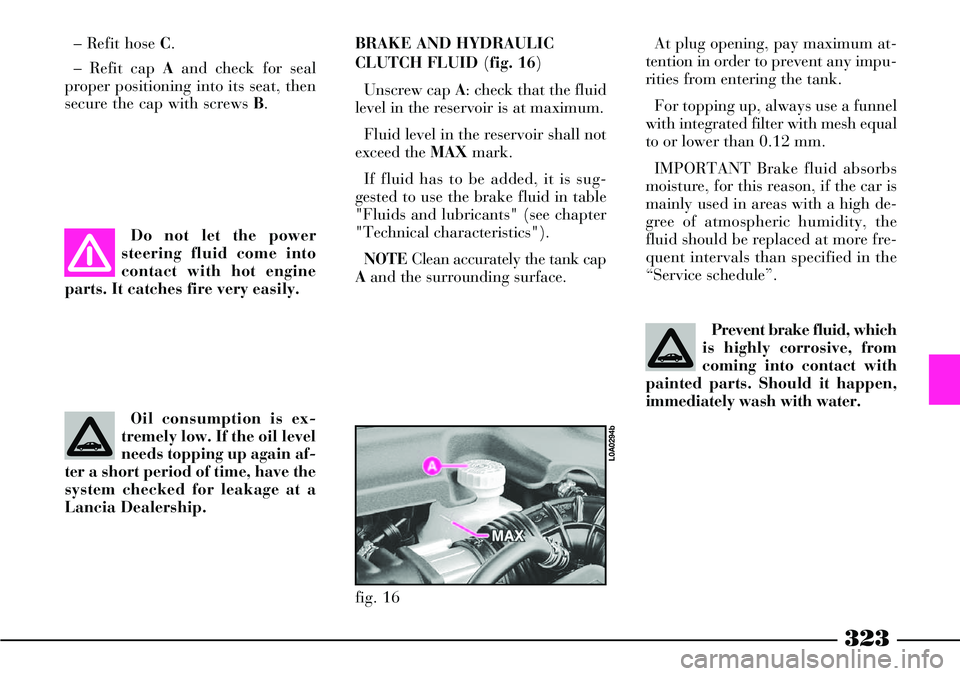
323
Oil consumption is ex-
tremely low. If the oil level
needs topping up again af-
ter a short period of time, have the
system checked for leakage at a
Lancia Dealership.BRAKE AND HYDRAULIC
CLUTCH FLUID (fig. 16)
Unscrew cap A: check that the fluid
level in the reservoir is at maximum.
Fluid level in the reservoir shall not
exceed the MAXmark.
If fluid has to be added, it is sug-
gested to use the brake fluid in table
"Fluids and lubricants" (see chapter
"Technical characteristics").
NOTEClean accurately the tank cap
Aand the surrounding surface.
Prevent brake fluid, which
is highly corrosive, from
coming into contact with
painted parts. Should it happen,
immediately wash with water.
Do not let the power
steering fluid come into
contact with hot engine
parts. It catches fire very easily.
fig. 16
L0A0294b
– Refit hose C.
– Refit cap Aand check for seal
proper positioning into its seat, then
secure the cap with screws B.At plug opening, pay maximum at-
tention in order to prevent any impu-
rities from entering the tank.
For topping up, always use a funnel
with integrated filter with mesh equal
to or lower than 0.12 mm.
IMPORTANT Brake fluid absorbs
moisture, for this reason, if the car is
mainly used in areas with a high de-
gree of atmospheric humidity, the
fluid should be replaced at more fre-
quent intervals than specified in the
“Service schedule”.
Page 330 of 386

329
USEFUL ADVICE FOR
LENGTHENING THE LIFE OF
YOUR BATTERY
To prevent rapidly draining the
battery and ensure that it continues
to work correctly, the following
should be noted:
– Terminals must always be firmly
tightened.
– Do not keep accessories (e.g.
sound system, hazard lights, parking
lights, etc.).
– When you park the car, ensure
the doors, boot and bonnet are
closed properly. The ceiling lights
must be off.
– Before working on the electrical
system, disconnect the negative
cable from the battery.– If after buying the car, you want
to install electric accessories which
require permanent electric supply,
visit a Lancia Dealership, whose
qualified personnel, in addition to
suggesting the most suitable devices
belonging to the Lineaccessori
Lancia, will evaluate the overall
electric absorption, checking
whether the car’s electric system is
capable of withstanding the load
required, or whether it should be
integrated with a more powerful
battery. These devices in fact take
electricity also when the ignition key
is removed (car parked, engine off),
and can gradually drain the battery.
The overall intake of these devices
(standard and after-market) must
be less than 0.6 mA x Ah (of the bat-
tery), as shown in the following
table.Battery Maximum
idle intake
70 Ah 42 mA
80 Ah 48 mA
100 Ah 60 mA
It is also important to remember
that high intake devices (such as
bottle warmers, vacuum cleaners,
cellular phones, frigo bar, etc.) will
speed up battery discharging when
powered with engine off or running
idle.
– Please note that when installing
additional systems in the car, incor-
rect wiring can be dangerous espe-
cially when concerning safety sys-
tems.
Page 331 of 386

330
SPARK PLUGS
The cleanness and soundness of the
spark plugs are very important for
keeping the engine efficient and pol-
luting emissions down.
The appearance of the spark plug,
if examined by expert eyes, is a good
way of pinpointing a problem even if
it has nothing to do with the ignition
system. Therefore, if the engine has
problems, it is important to have the
spark plugs checked at a Lancia
Dealership.
The spark plugs must be
changed at the times
specified in the Service
Schedule. Only use the type of
plugs indicated. If the heat ratio
is less than required or the life
specified is not guaranteed, prob-
lems can arise.
ELECTRONIC
CONTROL UNITS
When the car is being used normal-
ly, special measures are not neces-
sary.
The following instructions must be
followed very carefully, however, if
you work on the electrical system or
in cases where emergency starting is
necessary:
– never disconnect the battery from
the electrical system while the
engine is running
– disconnect the battery from the
electrical system if you are recharg-
ing it. The modern battery chargers
can discharge voltage up to 20V
– never perform emergency start-
ups with a battery charger. Always
use an auxiliary battery
– be particularly careful when con-
necting the battery to the electrical
system. Make sure that the polarity
is correct and that the connection is
efficient– do not connect or disconnect the
terminals of the electronic control
unit while the ignition key is at MAR
– do not check polarity through
sparking
– disconnect the electronic control
units if you are electrically welding
the car body. Remove the units if
temperatures exceed 80°C (special
operations on the bodywork, etc.).
Modifications or repairs
to the electrical system
carried out incorrectly
and without bearing the features
of the system in mind can cause
malfunctions with the risk of fire.